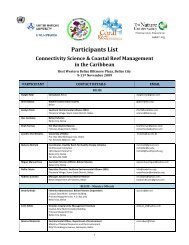The Global Water Crisis: Addressing an Urgent Security - Unu-inweh ...
The Global Water Crisis: Addressing an Urgent Security - Unu-inweh ...
The Global Water Crisis: Addressing an Urgent Security - Unu-inweh ...
Create successful ePaper yourself
Turn your PDF publications into a flip-book with our unique Google optimized e-Paper software.
4. Climate Ch<strong>an</strong>ge <strong>an</strong>d the Loss of Hydrological ‘Stationarity’<br />
All these challenges to the current status quo will be compounded in one way or <strong>an</strong>other by climate ch<strong>an</strong>ge, <strong>an</strong>d it will<br />
be import<strong>an</strong>t for decision-makers to underst<strong>an</strong>d why climate ch<strong>an</strong>ge will play such a crucial role. Aside from inducing<br />
warmer temperatures, decision-makers will need to grasp exactly how climate ch<strong>an</strong>ge will affect water security.<br />
We have known for some time that hydro-climatic hazards such as droughts <strong>an</strong>d floods have the potential to trigger<br />
or exacerbate social tensions that may lead to intra- <strong>an</strong>d inter-state conflict (Vidaurre et al., 2011). While conventional<br />
wisdom in water policy circles today has it that growing populations <strong>an</strong>d climate ch<strong>an</strong>ge do not necessarily tr<strong>an</strong>slate into<br />
increased water wars, the same wisdom does not apply to temperature. Higher temperatures have already resulted in lower<br />
precipitation in North Africa, for example, <strong>an</strong>d this has led to diminished agricultural production, greater unemployment<br />
<strong>an</strong>d growing unrest, especially among younger males. Scientists have modelled the connection between temperature <strong>an</strong>d<br />
conflict to demonstrate that conflict increases in lockstep with temperature. When conflict <strong>an</strong>alyses <strong>an</strong>d climate model<br />
data were assimilated, they projected a roughly 50% increase in armed conflict by 2030, with almost 400,000 additional<br />
battle deaths in Africa alone (Cullen, 2010).<br />
It is not only in already politically unstable regions, however, that climate ch<strong>an</strong>ge is expected to cause economic <strong>an</strong>d social<br />
disruptions. To underst<strong>an</strong>d why climate ch<strong>an</strong>ge is such a threat to established stability, it is import<strong>an</strong>t to underst<strong>an</strong>d the<br />
central role that water plays in our pl<strong>an</strong>et’s weather <strong>an</strong>d climate system.<br />
<strong>The</strong> fundamental threat that climate ch<strong>an</strong>ge poses relates to what hydrologists call ‘stationarity’. Stationarity is the notion<br />
that natural phenomena fluctuate within a fixed envelope of certainty, <strong>an</strong>d implies stability. It is because of stationarity<br />
that we have come to expect that winters will be so cold <strong>an</strong>d summers so hot; that melt from winter snow will always<br />
contribute roughly the same amount of water to our rivers; <strong>an</strong>d that rivers will rise so high in the spring <strong>an</strong>d fall so low<br />
in autumn. Stationarity suggests that lightening will strike only so frequently, <strong>an</strong>d that tornadoes will occur only at the<br />
most extreme margins of the weather conditions we have come to expect. Stationarity provides the certainty that is<br />
needed to build houses to withst<strong>an</strong>d winds of a certain speed <strong>an</strong>d snowfalls of a certain weight, <strong>an</strong>d to what size to build<br />
storm sewers because history has shown that rainstorms only last so long <strong>an</strong>d only result in so much run-off. Stationarity<br />
provides the foundation for the reliable functions of natural ecosystem processes that provide a stable <strong>an</strong>d resilient<br />
backdrop to hum<strong>an</strong> existence.<br />
By assuming stationarity within a defined r<strong>an</strong>ge, hum<strong>an</strong>kind has been able to create cities in which millions of people live<br />
with security, to develop water treatment <strong>an</strong>d delivery systems that provide safe drinking water to billions of people, <strong>an</strong>d<br />
to develop tr<strong>an</strong>sportation systems that allow m<strong>an</strong>y people to travel <strong>an</strong>ywhere in the world within a day. But the statistics<br />
<strong>an</strong>d the st<strong>an</strong>dards upon which these were based to create these modern miracles no longer apply. What is happening<br />
now is that increased temperatures are altering the patterns of movement of water through the global hydrological cycle.<br />
This me<strong>an</strong>s that the statistics from the past related to how surface, subsurface <strong>an</strong>d atmospheric water will act under a<br />
variety of given circumst<strong>an</strong>ces, <strong>an</strong>d on which we have come to rely, are no longer reliable.<br />
While it is well known that climate ch<strong>an</strong>ges naturally over time, we have enjoyed a relatively stable period over the last<br />
century. As a society, we have been lulled into complacency by this relative stability. During this period, we established<br />
our own idea of the limited r<strong>an</strong>ge of natural climate variability that we believed exists, <strong>an</strong>d then built our society <strong>an</strong>d<br />
the vast infrastructure that supports it around that r<strong>an</strong>ge. Our risk assessments were also built on these same notions of<br />
relative stability that may now no longer exist. This mistake has made societies vulnerable, <strong>an</strong>d this vulnerability is now<br />
being compounded by climate ch<strong>an</strong>ge. <strong>The</strong> warming of our climate has altered the fixed envelope of certainty within<br />
which we <strong>an</strong>ticipated natural phenomena to fluctuate, the result of which we are seeing through increased droughts,<br />
floods <strong>an</strong>d other extreme climatic events affecting the way we live.<br />
As of yet, there is no adequate replacement for stationarity statistics. Until a new way is found for subst<strong>an</strong>tiating appropriate<br />
action in the absence of stationarity, risks will become increasingly difficult to predict or to price.<br />
14 <strong>The</strong> <strong>Global</strong> <strong>Water</strong> <strong>Crisis</strong>: <strong>Addressing</strong> <strong>an</strong> <strong>Urgent</strong> <strong>Security</strong> Issue




